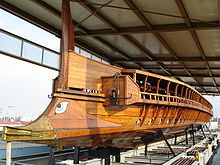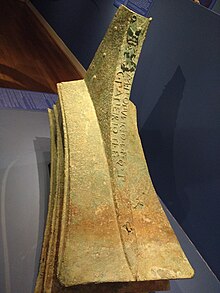Ramming

In warfare,rammingis a technique used in air, sea, and land combat. The term originated frombattering ram,a siege weapon used to bring down fortifications by hitting it with the force of the ram's momentum, and ultimately from malesheep.Thus, in warfare, ramming refers to hitting a target by running oneself into the target.
Today, hand-held battering rams are one tool among many used by law enforcement and military personnel fordoor breaching.[1]Forcible entryby criminals has been implemented using such methods asvehicles rammed into buildings.[2]
[edit]
This articleneeds additional citations forverification.(July 2023) |


Navies in antiquity commonly used the ram: the "beak" (Latin:rostrum) became an important part of the armament of thegalleysofImperial Rome.Theancient Greeksused theirtriremevessels for ramming as well. Inancient China,rams were largely unknown, as the lack of akeeland the flat shape of thejunk's bow was not conducive to constructing an elongated underwater spur.
The first recorded use of a ram in modern times in fighting between major warships occurred in theAmerican Civil Warat theBattle of Hampton Roadsin March 1862, when the armoredConfederatewarshipCSSVirginiarammed theUnionfrigateCumberland,sinking her almost immediately.
Another significant use of the naval ram occurred during theThird Italian War of Independence(June to August 1866) at thebattle of Lissa,betweenItalyandAustria.The Italian ironcladRe d'Italia,damaged aft by gunfire, had no functioning rudder. Lying helpless in the water, she was struck three times by the AustrianErzherzog Ferdinand Max,the flagship of the Austrian Commander-in-Chief AdmiralTegetthoff.The Austrian ship retreated unharmed as the Italian vessel rolled over and sank.
During theWar of the Pacificof 1879-1884, the Peruvian ironcladHuascarrepeatedly rammed the Chilean corvetteEsmeralda,sinking the wooden steam- and wind-powered ship (May 1879).
DuringWorld War I(1914-1918),HMSDreadnoughtrammed and sank German submarineU-29in 1915.[3]This was an incidental use of the ship's bow, however. In 1918 the Britishtroop shipHMTOlympicrammedSMU-103– the submarine sustained such heavy damage that its crew was forced toscuttleand abandon ship.
InWorld War II(1939-1945), naval ships often rammed other vessels, though this was often due to extraordinary circumstances, as considerable damage could be caused to the attacking ship. The damage that lightly-constructeddestroyerstook from using the tactic led theRoyal Navyto officially discourage the practice from early 1943, afterHMSHesperusspent three months in dry dock following her sinking ofU-357in December 1942, and afterHMSHarvesterwas torpedoed and sunk after damaging her propellers during the ramming ofU-444in March 1943.USSBuckleyrammed and was rammed byU-66in May 1944; andHMSEastonrammedU-458in 1943.
On 29 January 1943 theNew Zealandnaval trawlers,KiwiandMoarammed and wrecked the Japanese submarineI-1in shallow water at Kamimbo Bay,Guadalcanal,duringOperation Ke.The submarine of 2,135 tons was much larger and more heavily armed than the minesweeping trawlers of 607 tons each.
On 5 November 1942 theFinnish submarineVetehinenrammed the Soviet submarineЩ 305in the Sea of Åland and sank it.Vetehinenwas on a night patrol searching for Soviet submarines. A contact was found, and after confirmation of an enemy contact,Vetehinenlaunched a torpedo, which missed - probably due to launching at too short a distance.Vetehinenthen opened fire with its deck guns and managed to damage the Soviet submarine, which by then had started an emergency dive. The captain ofVetehinen,determined not to let the other submarine escape, ordered his submarine to ram the other vessel, which at last was a success.
During anti-submarine action, ramming was an alternative if a destroyer was too close to a surfaced submarine for her main guns to fire into the water. The famous British anti-submarine specialist CaptainFrederic John Walkerused this tactic from December 1941 to the end of World War II.
The British destroyerHMSCampbeltown(formerly USSBuchanan,supplied underLend-Lease) was disguised as a German destroyer for the purpose of ramming the gates of theNormandie dry dockatSt. Nazaireon 28 March 1942. This action aimed to prevent the Normandie dock ever being used by the German battleshipTirpitz.(It was the only dock on theWehrmacht-occupied Atlantic coast capable of repairing such a large vessel.) The operation succeeded, and a large explosivetime-bombcharge hidden in the bow of the ship exploded the next day, putting the dock out of commission for five years.
On 2 August 1943, while returning from a "Tokyo Express"night reinforcement mission in theSolomon Islands,the Japanese destroyerAmagirispotted USNPT boatsat a range of about 1,000 yards. Rather than open fire—and give away their position—the destroyer captain, Lieutenant Commander Kohei Hanami, turned to intercept and closed in the darkness at 30 knots. The slower, less maneuverable Japanese destroyer rammed and crushedPT-109,commanded by Lt.John F Kennedy.[4]
Lt. CommanderGerard Roope,the captain of theG-class destroyerHMSGlowworm,posthumously won theVictoria Crossfor the 1940 ramming of the German heavy cruiserAdmiral Hipperfollowing a close-range action in bad weather off the Norwegian coast. Recent claims suggest thatAdmiral Hipperwas actually attempting to ramGlowwormand that the two ships simply collided.[citation needed]
During the so-calledCod Warsof 1958 to 1976 between Britain and Iceland, unarmed Britishfishing trawlersfound themselves opposed byIcelandic Coastguardvessels and converted trawlers. As well asRoyal Navycoastguard vessels, Britain sent large, ocean-goingtugsandfrigatesto protect its subjects, and numerous ramming incidents occurred against both sides, sometimes with very serious consequences. The whole Icelandic fleet of naval trawlers and at least 15 Royal Navy frigates suffered damage in the third conflict only (1975-1976).
In 1988 the SovietMirka II-class light frigate (FFL 824) and theBurevestnik-class frigateBezzavetny(FFG 811) lightly rammed two US naval ships (the destroyerCaronand the cruiserYorktown) inside contested Soviet territorial waters in the Black Sea, near the port ofForos.None of the ships involved suffered significant damage.
On 30 March 2020 the Venezuelan patrol-boatNaiguatárammed the cruise shipRCGS Resoluteafter failing to damage it with a volley of gunfire. TheNaiguatáwas badly damaged from striking the strengthened hull of theResolute,built to break ice, and sank shortly afterwards.
Air warfare[edit]
Ramming in air combat is a last-ditch tactic that was used when all else had failed. The ramming pilot could use his entire aircraft as a ram or he could try to destroy the enemy's controls using the propeller or wing to chop into the enemy's tail or wing. Ramming took place when a pilot ran out of ammunition, yet was still eager to destroy an enemy, or when his plane had already been damaged beyond saving. Most ramming occurred when the attacker's aircraft was economically, strategically, or tactically less valuable than the enemy's, such as by pilots flying obsolescent aircraft against superior ones or by single-engine aircraft against multiple-engine bombers. Defenders rammed more often than invaders.
A ramming attack was not considered suicidal in the same manner askamikazeattacks—the ramming pilot stands a chance of surviving, though it was very risky. Sometimes, the ramming aircraft itself could survive to make a controlled landing, though most were lost due to combat damage or the pilot bailing out. Ramming was used in air warfare in the first half of the 20th century, in bothWorld Warsand in the interwar period. In the jet age, as air combat speeds increased, ramming occurred much less frequently—the probability of successfully executing (and surviving) a ramming attack approached zero.
Ground warfare[edit]
In World War II, at least one incident of a tank ramming an enemy tank has been reported. In 1944, an Irish GuardsShermanrammed aTiger IIduringOperation Goodwood.[5]
Siege warfare[edit]
In ancient and medieval conflicts, breaching of a fortification during sieges would commonly be attempted by repeated battering of an area of a wall or gate with abattering ram,a type ofsiege engine.
Vehicle ramming attacks in terrorism[edit]
TheFBIdescribes "vehicle ramming attacks—using modified or unmodified vehicles—against crowds, buildings, and other vehicles".[6]Such attacks are often carried out bylone-wolf terrorists.[7]Examples of ramming attacks as acts ofterrorisminclude theSeptember 11 attacks,the2014 Jerusalem tractor attack,the2006 UNC SUV attack,the2008 Jerusalem bulldozer attack,and the2008 Jerusalem vehicular attack.
Ram-raidingis sometimes used by criminals to breach shops to steal cash or merchandise.
References[edit]
- Notes
- ^Jon Johnson."Police nab stalker in women's attic".Eastern Arizona Courier.Retrieved26 November2021.
- ^"Bank rammed by armed robbers".Thelocal.se.15 January 2008.Retrieved26 November2021.
- ^Koerver, Hans Joachim (2020).The Kaiser's U-Boat Assault on America Germany's Great War Gamble in the First World War.Havertown: Pen & Sword Books Limited.ISBN978-1-5267-7387-6.OCLC1202468466.
{{cite book}}:CS1 maint: date and year (link) - ^"PT-109".Navsource.org.
- ^Daglish. pp. 177̣–178.
{{cite book}}:Missing or empty|title=(help) - ^Department of Homeland Security, Federal Bureau of Investigation (14 February 2012)."DHS-FBI Warning: Terrorist Use of Vehicle Ramming Tactics".Department of Homeland Security, Federal Bureau of Investigation.Retrieved7 September2014.
- ^"Background: Ramming terror attacks in recent years".Jerusalem Post.2011-08-29.Retrieved7 September2014.
- Bibliography
- Hardesty, Von.Red Phoenix: The Rise of Soviet Air Power 1941–1945.Smithsonian, 1991.ISBN0-87474-510-1
- Hastings, Max(2008).Retribution.New York: Knopf.ISBN978-0-307-26351-3.
- Sakaida, Henry.Japanese Army Air Force Aces 1937–45.Botley, Oxford, UK: Osprey Publishing, 1997.ISBN1-85532-529-2
- Sherrod, Robert.History of Marine Corps Aviation in World War II.Washington, D.C.: Combat Forces Press, 1952.
- Takaki, Koji and Sakaida, Henry.B-29 Hunters of the JAAF.Botley, Oxford, UK: Osprey Publishing, 2001.ISBN1-84176-161-3
- Tillman, Barrett.Corsair.United States Naval Institute, 1979.ISBN1-55750-994-8

